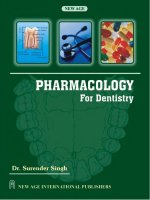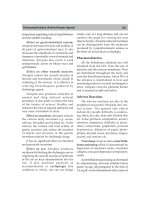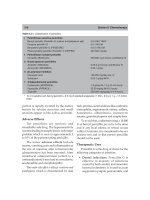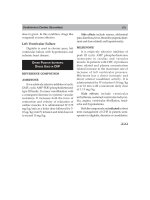Pharmacology for dentistry phần 66
Bạn đang xem bản rút gọn của tài liệu. Xem và tải ngay bản đầy đủ của tài liệu tại đây (87.75 KB, 5 trang )
Tetracyclines, Chloramphenicol and Chemotherapy of UTI
4.
5.
6.
7.
9.
10.
ducreyi, granuloma inguinale caused by
Calymmatobacterium granulomatis.
As an alternative drug in the treatment
of gonorrhoea and syphilis in patients
allergic to penicillin.
Dermatological infections: Acne
vulgaris, when antibiotic therapy is
considered necessary.
Ophthalmic infections: Due to susceptible strains of N. gonorrhoeae, staphylococci, H. influenzae and in the treatment of trachoma.
Prophylaxis and treatment of Traveller’s
diarrhoea.
Miscellaneous infections caused by
susceptible strains of bacteria causing
psittacosis, cholera, melioidosis, leptospirosis, brucellosis, bartonellosis,
plague, tularemia, Campylobacter fetus
infection, rickettsial infections including
typhus and Q fever, relapsing fever due
to Borrelia recurrentis and actinomycosis in penicillin allergic patients.
As an adjunct in acute intestinal
amoebiasis.
Prophylaxis of malaria due to P.
falciparum.
CHLORAMPHENICOL
It is a broad spectrum antibiotic originally
derived from Streptomyces venezuelae and later
on became the first completely synthetic
antibiotic. It is used as palmitate and sodium
succinate salt in given dosage.
Dose: 250-500 mg QID oral, 1-2 g IM
injection, 0.5-1.0% topical (eye ointment/
drops/applicap and ear drops).
Chloramphenicol is a potent inhibitor of
microbial protein synthesis. It acts by
313
binding reversibly to the 50S submit of the
bacterial ribosome. It inhibits the peptidyl
transferase step of protein synthesis. It is
bacteriostatic broad-spectrum antibiotic
active against gram positive and negative
organisms, Rickettsia, the Chlamydia of the
psittacosis, lymphogranuloma group and
Mycoplasma pneumoniae. The other organisms
sensitive to chloramphenicol are E. coli, K.
pneumoniae, Shigella, and certain strains of
Brucella, Pasteurella, Proteus and Vibrio comma.
It exerts bactericidal against H. influenzae,
Strep. pneumoniae and N. meningitidis.
Pharmacokinetics
Chloramphenicol is completely absorbed
after oral administration, bound to plasma
protein (approximately 60%) and widely
distributed in body. It crosses the blood-brain
and placental barrier and shows its presence
in CSF, bile and milk. It is conjugated with
glucuronic acid in liver and excreted in urine.
Small amount is excreted in urine in
unchanged form.
Adverse Effects
Allergic reaction includes skin rashes,
drug fever, dermatitis, angioneurotic
edema.
Bone marrow depression includes
aplastic anaemia, leukopenia, agranulocytosis, thrombocytopenia.
Gray baby syndrome: Premature babies
develop vomiting, hypothermia, abdominal
distension, shallow irregular respiration and
further leading to gray cyanosis, vascular
collapse, shock and death.
CNS toxicity includes headache, mental
confusion, internal ophthalmoplegia, peripheral neuritis, depression, optical neuritis.
314
Other adverse effects include superinfection, hepatotoxicity and typhoid shock.
Therapeutic Uses
Because of bone marrow toxicity of
chloramphenicol, its use is restricted to the
treatment of infection caused by S. typhi and
paratyphi (treatment of typhoid fever).
Other indications in which chloramphenicol can be used are H. influenzae meningitis,
urinary tract infections, anaerobic infections
caused by Bacteroides fragilis and locally in eye
and external ear infections.
CHEMOTHERAPY OF URINARY
TRACT INFECTIONS
URINARY ANTISEPTICS
Urinary antiseptics are orally administered
agents that exert antibacterial activity in the
urine but have no systemic antibacterial
activity. Urinary antiseptics are listed as in
table 9.2.2.
NITROFURANTOIN
It is bacteriostatic and but bactericidal
against many gram positive and negative
organisms in higher concentration and
acidic urine. Pseudomonas aeruginosa and
various strains of Proteus are resistant. It
Section 9/ Chemotherapy
antagonizes the action of nalidixic acid and
its activity is enhanced by lower pH. After
oral administration it is rapidly and
completely absorbed from GIT,
metabolized in liver and less than half is
excreted unchanged in urine.
It is used exclusively for urinary tract
infections. The side effects include nausea,
vomiting, diarrhoea, anorexia, leukopenia,
haemolytic anaemia, jaundice, dizziness and
headache. On chronic use can lead to peripheral neuritis and interstitial pulmonary fibrosis.
METHENAMINE
Methenamine mandelate is a salt of
mandelic acid and methenamine and both of
these possess property of urinary antiseptic.
It is rapidly absorbed in gastrointestinal tract
and excreted unchanged in urine, where it
broken down in acidic pH (< 5) of urine and
formaldehyde is released, which inhibits most
of the bacteria. It is administered with sodium
biphosphate, mandelic acid or ascorbic acid
to keep the urinary pH below 6. Its use is
restricted to chronic, resistant type of UTI.
Adverse effects are gastritis, hematuria,
chemical cystitis and skin rash. It is
contraindicated in renal failure and hepatic
insufficiency.
Table 9.2.2: Classification of urinary antiseptics.
Nitrofurantoin (FURADANTIN)
50-100 mg QID
Methenamine (as mendelate & hippurate)
1 g TDS-QID
Phenazopyridine (PYRIDIUM)
200-400 mg TDS
Other antimicrobial agents used in urinary tract infection e.g. sulfonamides, quinolones, penicillins,
cephalosporins etc. (details are discussed in respective sections).
Tetracyclines, Chloramphenicol and Chemotherapy of UTI
PHENAZOPYRIDINE
It is used for symptomatic relief of
urinary burning sensation and urgency due
to cystitis. It is a orange dye and excreted in
urine. It has no antibacterial property.
URINARY ALKALINIZERS
AND
ACIDIFIERS
Certain antimicrobial agents used to treat
urinary tract infections act better in acidic
pH i.e. nitrofurantoin, tetracycline,
methenamine, cloxacillin. Certain other antimicrobial agents such as gentamicin,
cephalosporins, fluoroquinolones, cotri-
315
moxazole act better in alkaline medium. In
specific cases, where urine of desired reaction (acidic or alkaline), some acidifying or
alkalinizing agents is sometimes used to
get a desired clinical result. Urinary pH
can be increased by carbonic anhydrase
inhibitors (e.g. acetazolamide) and
prolonged therapy requires bicarbonate
administration. In treatment of drug poisoning, the excretion of some drugs can
be hastened by acidification and alkalinization of the urine. Ammonium chloride
is used to acidify urine and potassium acetate/citrate is used to alkalinize urine.
This page
intentionally left
blank
r
r
e
e
t
t
p
p
a
CChh
9.3
1.4
Beta Lactam
Pharmacodynamics
(Mode
of Action of Drugs)
Antibiotics
PENICILLINS
Penicillin was originally extracted from the
mould Penicillium notatum but now it is
extracted from its related mould Penicillium
chrysogenum due to its high yield. Penicillin
consists of thiazolidine ring fused with a
beta lactam ring which is essential for its
antibacterial activity. These two rings forms
a nucleus named as 6-aminopenicillanic
acid.
Mechanism of Action
The bacterial cell wall is a rigid outer
layer that completely surrounds the
cytoplasmic membrane. Penicillin and other
betalactam antibiotics inhibit bacterial
growth by interfering with a specific step
in bacterial cell wall synthesis. Penicillins
are classified as in table 9.3.1.
BENZYL PENICILLIN
It is the most potent β-lactam antibiotic
and inhibits the growth of susceptible
microorganism in vitro in lowest
concentration and is available in water
soluble sodium and potassium salts.
Penicillin is effective against gram positive and negative cocci and some gram
positive bacilli. Among the cocci, streptococci are highly sensitive. Gonococci, pneumococci and meningococci are sensitive to
penicillin.
Among the bacilli, gram positive Bacillus
anthracis, Corynebacterium diphtheriae,
Clostridium species are highly sensitive.
Among the spirochetes, Treponema pallidum
is highly sensitive to penicillin.
Gram negative bacilli, fungi, protozoa,
rickettsiae, chlamydiae, viruses and
Mycobacterium tuberculosis are totally
insensitive to penicillin.
Pharmacokinetics
After oral administration, benzyl
penicillin is destroyed by gastric acid. It
is mainly absorbed from the duodenum.
It is absorbed in aqueous solution rapidly
after intramuscular or subcutaneous
administration. Penicillin is widely
distributed in the body after absorption
and approximately 60% of plasma
penicillin is bound to albumin. The major









